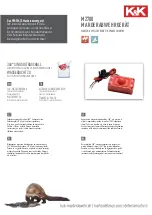
Section 8. Operation
Offset Voltage Compensation
Related Topics
•
Auto Calibration — Overview
(p. 92)
•
Auto Calibration — Details
(p. 344)
•
Auto-Calibration — Errors
(p. 490)
•
Offset Voltage Compensation
(p. 323)
•
Factory Calibration
(p. 94)
•
Factory Calibration or Repair Procedure
(p. 476)
Summary
Measurement offset voltages are unavoidable, but can be minimized.
Offset voltages originate with:
• Ground currents
• Seebeck effect
• Residual voltage from a previous measurement
Remedies include:
• Connect power grounds to power ground terminals (
G
)
• Use i
nput reveral (
RevDiff
=
True
) with differential measurements
• Automatic offset compensation for differential measurements when
RevDiff
=
False
• Automatic offset compensation for single
-ended measurements when
MeasOff
=
False
• Better offset compens
ation when
MeasOff
=
True
• Excitation reversal (
RevEx
=
True
)
• Longer settling times
Voltage offset can be the source of significant error. For example, an offset of 3
μV on a 2500 mV signal causes an error of only 0.00012%, but the same offset on
a 0.25 mV signal causes an error of 1.2%. The primary sources of offset voltage
are ground currents and the Seebeck effect.
Single-ended measurements are susceptible to voltage drop at the ground terminal
caused by return currents from another device that is powered from the CR1000
wiring panel, such as another manufacturer's telecommunication modem, or a
sensor that requires a lot of power. Currents >5 mA are usually undesirable. The
error can be avoided by routing power grounds from these other devices to a
power ground
G
terminal on the CR1000 wiring panel, rather than using a signal
ground ( ) terminal. Ground currents can be caused by the excitation of
resistive-bridge sensors, but these do not usually cause offset error. These
currents typically only flow when a voltage excitation is applied. Return currents
associated with voltage excitation cannot influence other single-ended
measurements because the excitation is usually turned off before the CR1000
moves to the next measurement. However, if the CRBasic program is written in
such a way that an excitation terminal is enabled during an unrelated measurement
of a small voltage, an offset error may occur.
The Seebeck effect results in small thermally induced voltages across junctions of
dissimilar metals as are common in electronic devices. Differential measurements
are more immune to these than are single-ended measurements because of passive
voltage cancelation occurring between matched high and low pairs such as
1H
/
1L
. So use differential measurements when measuring critical low-level
323
Содержание CR1000
Страница 2: ......
Страница 4: ......
Страница 6: ......
Страница 32: ......
Страница 36: ......
Страница 38: ......
Страница 40: ......
Страница 60: ...Section 4 System Quickstart Figure 16 PC200W View Line Graph 60 ...
Страница 96: ......
Страница 98: ...98 ...
Страница 302: ......
Страница 350: ...Section 8 Operation Figure 91 Pulse Sensor Output Signal Types Figure 92 Switch Closure Pulse Sensor 350 ...
Страница 453: ...Section 8 Operation Figure 115 Using the Keyboard Display 453 ...
Страница 454: ...Section 8 Operation 8 8 1 Data Display Figure 116 Displaying Data with the Keyboard Display 454 ...
Страница 456: ...Section 8 Operation Figure 118 Real Time Custom 456 ...
Страница 457: ...Section 8 Operation 8 8 1 3 Final Memory Tables Figure 119 Final Memory Tables 457 ...
Страница 458: ...Section 8 Operation 8 8 2 Run Stop Program Figure 120 Run Stop Program 458 ...
Страница 460: ...Section 8 Operation Figure 122 File Edit 460 ...
Страница 461: ...Section 8 Operation 8 8 4 PCCard Memory Card Display Figure 123 PCCard CF Card Display 461 ...
Страница 478: ......
Страница 506: ......
Страница 536: ......
Страница 636: ......
Страница 642: ......
Страница 644: ......
Страница 676: ......
Страница 677: ......
















































